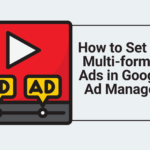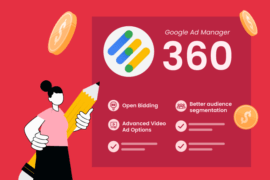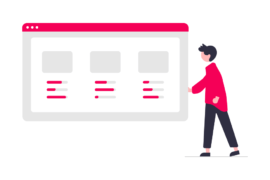Are you looking to optimize your online advertising strategy and maximize your revenue potential? Look no further than Google Ad Manager Account, a powerful platform that offers a comprehensive suite of features to help you effectively manage and monetize your digital ad inventory.
Given that Google owned 92% of the global search market share in 2021, it’s no wonder that nearly three-fourths of all marketers recommend a Google Ads presence for businesses. With such dominance in the search market, leveraging Google’s advertising ecosystem becomes essential for businesses to thrive.
In this introductory guide, we will explore what Google Ad Manager Account is all about, delve into its key features and benefits, and provide valuable insights on how you can reduce unfilled impressions to enhance your ad performance. So, let’s dive in and unlock the full potential of the Google Ad Manager Account.
Let’s understand what Google Ad Manager account is?
What is Google Ad Manager Account (GAM)?
The Google Ad Manager Account is a publisher’s ultimate ally. Introduced in 2018, it seamlessly integrates DoubleClick for Publishers and DoubleClick Ad Exchange into a unified platform. With this centralized dashboard, publishers gain complete control over multiple Google Ads accounts.
At the heart of the system lies the manager’s account, empowering publishers to streamline their digital domain. From managing ad campaigns to optimizing revenue streams, this powerful tool streamlines operations and maximizes efficiency.
Moreover, it allows you to deliver targeted ads, analyze performance, and adapt to the ever-changing digital landscape with ease. The Google Ad Manager account is the catalyst for publishers to thrive in the dynamic world of online content creation and monetization.
Also Read – How to Use Google Ad Manager with AdSense and Ad Exchange
How To Get Started with Google Ad Manager Account?
Getting started with Google Ad Manager Account is a straightforward process that involves a few simple and easy steps. Here’s a quick guide to help you kickstart your journey:
- Sign up: Visit the Google Ad Manager website and click “Get Started” to create your account.
- Set up your network: Define your network’s name, time zone, and settings.
- Create ad units: Specify the ad unit’s name, size, and settings under the “Inventory” tab.
- Generate ad tags: Get the code snippets to display ads on your website or app.
- Set up ad orders and creatives: Create ad orders and upload or create the ads.
- Preview and test: Use the preview tools to ensure everything is working correctly.
- Start serving ads: Your ads will now be delivered to your website or app.
For detailed instructions and troubleshooting, refer to the official Google Ad Manager support documentation.
Top Features of Google Ad Manager Account
There are plenty of features of Google ad manager account, here are some of them:
Centralized Account Management
With a Google Ads Manager Account, you can easily manage and oversee multiple Google Ads accounts from a single, centralized dashboard. This eliminates the need for individual log-ins and allows for efficient control of all your ad accounts.
Hierarchy and Access Control
The manager’s account sits at the top of the hierarchy, granting you administrative control over the sub-accounts. You can assign different levels of access to users, ensuring appropriate permissions and smooth collaboration within your team.
Seamless Navigation
The user-friendly interface of the Google Ads Manager Account makes it easy to navigate between different accounts, campaigns, and performance metrics. You can swiftly switch between accounts and access the information you need without any hassle.
Cross-Account Insights
Gain valuable insights and performance data across all your managed accounts. The Google Ads Manager Account provides consolidated reporting, enabling you to analyze trends, identify opportunities, and make informed decisions to optimize your advertising strategies.
Efficient Campaign Management
Streamline your campaign management process by using shared budgets and audience lists across multiple accounts. This simplifies budget allocation and ensures consistent targeting and messaging for your ads.
Simplified Billing
Google Ads Manager Account offers consolidated billing, allowing you to manage and track your advertising expenses efficiently. You can view and manage billing details for all your accounts in one place, simplifying the financial aspect of your ad management. With the assistance of a bookkeeper, you can maintain accurate financial records, ensuring that your ad expenses are correctly tracked and managed.
Support and Guidance
Next, and one of the most helpful features is that Google provides comprehensive support and resources to help you make the most of your Google Ads Manager Account. Access tutorials, guides, and expert assistance to enhance your understanding and optimize your ad management strategies.
Now that you know the features, let’s delve deeper and take a look at what all are the benefits that a Google Ad Manager account has to offer.
You may also like to know – What are Macros in Google Ad Manager?
Benefits of Google Ad Manager Account
There are a number of benefits of having a Google ad manager account, here are some of them.
Easier Management of Campaigns
It’s like a single-stop shop for everything you need will need to manage multiple accounts together. Thus, you will be easily able to test your campaigns and bring out better results. Successful paid campaigns are all about testing, the all-in-one flexibility of the Google ad manager account allows you to do just the same. It makes your campaign management efforts more efficient, which eventually impacts the bottom line.
Streamlined Management
With the Google Ad Manager Account, publishers can efficiently manage their ad operations from a single, centralized dashboard. It provides a comprehensive view of ad inventory, allowing publishers to easily monitor, optimize, and control their ad placements across multiple platforms.
Improved Efficiency
By eliminating the need for individual log-ins and providing a unified interface, the Google Ad Manager Account simplifies the management of multiple accounts. You can seamlessly navigate between different campaigns, view performance metrics, and make adjustments with ease.
Comprehensive Reporting
The platform offers consolidated reporting, providing you with a holistic view of your ad performance across multiple accounts. This enables you to analyze data, identify trends, and make data-driven decisions to optimize your advertising strategies.
Enhanced Collaboration
The Google Ad Manager Account allows you to grant different levels of access to team members, facilitating seamless collaboration. You can assign roles, control permissions, and work together effectively to streamline ad operations.
Efficient Resource Allocation
Utilize shared budgets and audience lists across multiple accounts to streamline resource allocation and maximize the impact of your advertising efforts. This ensures consistent messaging, targeting, and budgeting across your campaigns.
Monetization Opportunities
For publishers, the Google Ad Manager account opens up monetization opportunities by connecting you with a vast network of advertisers. You can efficiently manage ad inventory, optimize revenue streams, and maximize your earning potential.
Advanced Ad Management Features
Publishers can take advantage of advanced ad management features, such as audience segmentation, dynamic allocation, and programmatic selling. These tools empower publishers to tailor their ad offerings, deliver personalized experiences, and maximize the value of their ad inventory.
Now that you have got a fair understanding of what a Google Ad Manager account is, its features, and its benefits, let’s understand how to reduce unfilled impressions from it.
Also Read – How to Generate Reports in Google Ad Manager
What are Unfilled Impressions in Google Ad Manager Account (GAM?
Ad networks and exchanges record the count of ads that fill up publishers’ inventories. For AdSense publishers, Google Ad Manager does that work. In the case when Ad Manager (or the ad network/exchange) is unable to find any ad to fill up the inventory, it is considered as an unfilled impression.
Why does this happen? This happens when both the ad network and the demand partner are unable to find suitable impressions for the advertiser and header bidding (auction for the ad impressions) is unable to take place.
Consequently, the ad server sends back a ‘blank impression’ to Ad Manager which gets counted as an unfilled impression. Simply put, an unfilled impression or a blank impression is an ad call which returned without an ad because no impressions were found eligible to serve.
Reasons for Unfilled Impressions in Google Ad Manager
There are a variety of factors that can lead to unfilled impressions一from technical issues to ignorance on the part of the publisher. Understanding the reasons why inventory goes unsold can help you minimise risk. Here are a few common reasons for unfilled impressions.
- Supply-demand balance:
Sometimes, the publishers are at fault. They add too many ad units on their websites in the hope to get higher revenue through extra impressions. The result? Supply outstrips demand and impressions go unsold.
- Ad slot-request ratio:
Similar to the point above, sometimes the header of the GPT (Google Publisher Tag) tag recognizes a high number of ad slots. But on the contrary, the number of ad display calls are too little to meet the supply. Here, having SRA (single request architecture) also factors in.
- No fallback ad network:
Ad networks play a significant role in demand generation for publishers; if direct ad sales between publishers and advertisers does not work out. Hence, not having a fallback ad network configured could lead to unfilled impressions.
- Low ad viewability:
Viewability is one of the most significant factors in measuring ad impressions and their value, with many networks and exchanges using it as a metric. Ad slots or ad inventory with less than 50% viewability may be at higher risk of being undersold.
- Ineffective setup or configuration:
5. During setup, one common mistake many publishers make is not placing house ads to fill any remnant inventory. Moreover, improper setup of line items can also be a possible reason of unfilled impressions (more coming up on this later).
It is important for publishers to have a general idea of each of the above reasons to understand their contribution in causing or worsening the incidence of unfilled impressions. - Issues with Line Items
Inactive line items are one of the root causes of unfilled impressions. Many of the reasons are directly or indirectly related to line items. Hence, the next step should be to find line items that do not serve any ads. Here’s how to do it:
Sign in to your Google Ad Manager account.
1. Click Delivery > Line items.
2. Apply Filters to find specific line items and refer to the ‘status’ of the line item.
Depending on the status of the line item viz. draft/inactive, ready, or delivering, the actions might vary.
3. Once line items are fixed, it would make sense to implement proper targeting methods by enabling ad targeting based on device, connection, key value, geography; and others, if applicable.
Also, there are Ad Manager delivery tools which can help publishers understand why line items might not be functioning. In the case where no line items cater to ad spaces, that means there are going to be unfilled impressions.
Finding Unfilled Impressions in Google Ad Manager
Once publishers have the reasons, detecting them is the next step to be able to deal with them. Here goes the steps to do that:
- Sign in to your Google Ad Manager account.
- Go to Reports > Queries > New query.
- Go to Edit and set a data range.
- Under Dimensions, type Ad unit (to see ad unit wise unfilled impressions) and Requested ad sizes (to see ad size wise unfilled impressions).
- Under Metrics, check mark the Unfilled impressions box.
- Hit Run.



Once publishers have the report in hand, it is wise to save it and refer to the Ad unit and Ad request size section to find the location of the tags. This will help you figure out which ad types are reporting the maximum volume of unfilled impressions.
FYI, till June 2018, DFP and AdX were separate entities before they became an integrated product, Google Ad Manager. Back then, publishers used to refer to DFP to check reports like unfilled impressions. Now, that happens on Ad Manager.
Alternate Way to Find Unfilled Impressions
- Sign in to your Google Ad Manager account.
- In Home, scroll down to Top detected yield partners.
- Click the View in query tool option.
- Click Edit and follow the same steps under New query, as stated in the above section.


Ad Manager gives the option to see level-wise reports. While the above method allows publishers to see direct reports, the other way of reporting looks like this:
In this method, sometimes the unfilled impressions checkbox may not be selectable. Here, the condition is that publishers need to integrate ‘demand partners’ as ‘yield partners’ for the data to get fetched in the report.
In addition, just like the first method, this report also gives publishers the insights they need to find the ad types which witness the most unfilled impressions. As a practice, publishers should also check the average ads per page, i.e., total number of impressions / total number of page views. If the resulting number is small, it is an indication of unfilled impressions.
How to Reduce Unfilled Impressions
#1 Remove some ad slots
The first thing to look at is the report fetched via Ad Manager一Ad unit and Ad request sizes. The ideal step? Eliminate the highlighted ad spaces from the webpage by referring to tag placement insights.
#2 Header bidding
Currently, header bidding is the most relied-upon way for publishers to generate demand. The right header bidding partners helps increase ad fill rate and CPMs for increasing competition for the inventory.
#3 Inventory segmentation
Segment the ad inventory to get more third-party demand partners. Segmentation allows a part of the inventory to be targeted to specific geographies, networks, etc. This helps get higher chances of filled inventory. Also, try to set a frequency cap on line items to maximize the fill rate from third-party partners.
#4 Viewability and auto-refresh ads
Compromised ad viewability and poor implementation of auto-refresh ads often lead to unfilled impressions. Make sure that viewability standards are met and that there’s a decent time gap between auto-refresh ads (ideally, between 30 to 60 seconds depending on the average session duration of a website).
#5 Ad placement
In the ‘reasons for unfilled impressions’ section, the first point stated that publishers create too many ad slots, which reduces demand. Rather than doing that, publishers should be mindful and experiment with ad placements, e.g. replacing non-standard small ad units with standard larger ad units, instead of increasing the number of ads.
Moreover, if you noticed, a few reasons for unfilled impressions are stated certain things that publishers ‘don’t do’, e.g. not having an ad network or not placing house ads. Therefore, in order to deal with unfilled impressions, the plan of action should be to do the opposite一sign up with a decent ad network and place house ads to fill remnant inventory.
Final Words
Apart from the reasons explained above, there are some everyday factors that may, or may not, lead to unfilled impressions but are worth observing. These include:
- High CPM floors affect advertisers’ purchase behavior toward the inventory.
- Inadequate demand to monetize impressions due to non-English geographical traffic.
- Slow page load time disrupts the ad renderings in a given user session.
- Blank ads and discrepancies in reporting made from the ad networks’ end.
The issue of unfilled impressions is probably everlasting. So the industry accepts it up to some extent (10-15%). However, platforms like Google Ad Manager give publishers the control to take necessary corrective actions. Therefore, it is doable to reduce unfilled impressions, even for publishers with little technical knowledge or developer skills, if done right.
FAQs
Google Ad Manager Account is a platform that helps publishers manage and monetize their digital ad inventory.
Google Ad Manager counts mobile app impressions in accordance with industry standards. The impression of a mobile app occurs when one or more pixels of the ad creative are visible on the device’s screen. Currently, this methodology is used by Ad Exchange creatives, some Ad Manager creative formats, and Open Bidding.
A competitor’s new account or an adjustment to their existing account can have an impact on how many impressions your ads receive. For example, your biggest competitor might raise their bids, pushing your ad off the first page. Impression numbers may then decrease.
Set a data range in Edit. Under Dimensions, select Ad unit (to see unfilled impressions by ad unit) and Requested ad sizes (to see unfilled impressions by ad size). Check the Unfilled impressions box under Metrics. Press the Run button.

Deepak has a keen eye for detail and a deep understanding of the ad tech landscape. Whether it’s through in-depth articles, thought-provoking insights, or compelling storytelling, he’s dedicated to helping people navigate the complex world of ad tech with the simplicity of his words.







